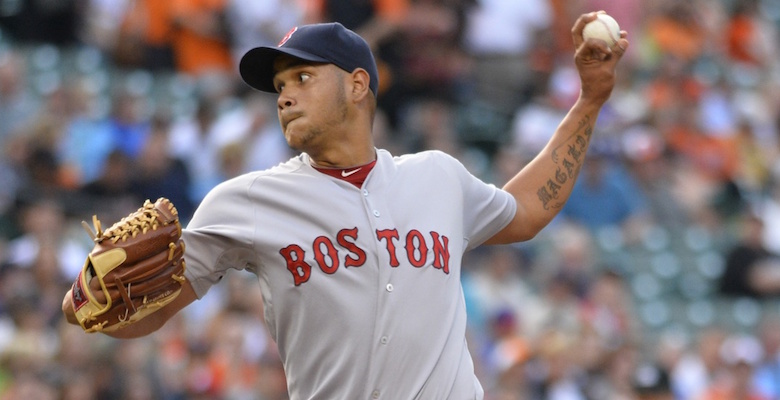In a season full of frustration, the arrival of Eduardo Rodriguez has been one of the few consolation prizes for Red Sox fans. Talented young pitchers are enough to send any fan’s heart into a flutter, but when you’ve watched Boston’s 2015 rotation on a daily basis, a hurler with the youth and potential of Rodriguez becomes doubly exciting.
The buzz surrounding Rodriguez began to grow last August after the Red Sox acquired him for Andrew Miller, and his velocity took a noticeable step forward in the season’s final weeks. Rodriguez entered the offseason as one of baseball’s most highly touted pitching prospects and ranked No. 4 overall on BP’s preseason list of Red Sox farmhands.
With the club’s woeful rotation threatening to derail any hopes of contention by late May, Ben Cherington had little choice but to hand Rodriguez his big league debut. That first outing against the Rangers, in which Rodriguez allowed three hits and no runs over 7 2/3 innings, set some unrealistic early expectations for the young left-hander.
Nevertheless, after his first seven starts, Rodriguez has proven worthy of a spot on the team’s starting staff. Through 41.1 innings, the 22-year-old has posted a 3.92 ERA and 3.37 FIP, while compiling a 21.3% strikeout rate and 7.7% walk rate. Outside of two poor performances, he has looked more than capable of excelling in the big leagues.
The most impressive part of Rodriguez’s repertoire is a four-seam fastball that averages 95.1 mph, according to Brooks Baseball, and that he does a good job of commanding to both sides of the plate. For a 22-year-old lefty, that type of velocity is rare and certainly a reason to be enthusiastic about his future.
Rodriguez has the second highest fastball velocity of any left-handed starter in the majors this season, behind only Chris Sale.
In fact, Rodriguez has the second highest fastball velocity of any left-handed starter in the majors this season behind Chris Sale. His ability to get swings and misses with the four-seamer allows Rodriguez to mix in a changeup and slider that aren’t quite of the same quality as his fastball but do serve as solid change-of-pace offerings.
Given that he throws his four-seamer 69.2% of the time, Rodriguez’s changeup has been effective as an alternative. The pitch has yielded an .083 slugging percentage against and been the youngster’s main source of whiffs with a 36.4% whiff/swing rate, the highest of his three offerings.
Where Rodriguez has run into trouble is when he has to pitch with men on base. In an eyewitness report on Rodriguez back in May, BP’s Al Skorupa wrote that the lefty struggles with runners on, stating that his “command falls a full grade from [the] stretch.”
Thus far in Rodriguez’s MLB career, the numbers certainly bear this out. With the bases empty, he has allowed a .180/.234/.260 line against opposing batters. When pitching from the stretch, opponents have hit .278/.371/.453 versus Rodriguez. Moreover, that he has succumbed to big rallies in his two poor starts against the Blue Jays and Orioles demonstrates that things can get out of hand in a hurry when Rodriguez is forced to pitch with men on base.
The fact Rodriguez has been tipping some of his pitches from the stretch certainly contributed to these struggles as well. The manner in which the young southpaw tipped his pitches against the Orioles has been well documented, and it’s something both he and the Red Sox will have to work on moving forward. It shouldn’t represent much of a long-term concern.
The biggest key for Rodriguez’s development is how much he can improve his secondary pitches. Both his changeup and slider have shown flashes of becoming solid offerings, but neither is near the level of his fastball. Considering how much Rodriguez relies on his four-seamer, it’s little coincidence he’s had some issues getting through big league lineups multiple times through the order.
Whether Rodriguez looks to add another offering, such as a cutter, or simply sharpens his changeup and slider in the coming years remains to be seen. At 22 years old, he’s one of the youngest starters in MLB, and left-handers who consistently throw 95 mph certainly don’t grow on trees.
For that reason, Rodriguez has a strong foundation upon which he can build and improve. The strides he’s made over the last 12 months point to a pitcher who is still growing and learning, and a youngster who has the aptitude to make adjustments as he continues to mature.
Young pitchers are renowned for being fickle and unpredictable, but Rodriguez has all the ingredients one can ask for in a prospective major league starter. For a Red Sox team that hasn’t exactly developed much in the way of good, young hurlers recently, Rodriguez represents one of the club’s more intriguing youngsters in quite some time.
The future is uncertain for any player, no matter their talent. Yet Rodriguez has the look of a young, cost-controlled pitcher that Boston can rely on for years. In today’s MLB, that’s about as valuable an asset as one can ask for.
Photo by Tommy Gilligan/USA Today Sports Images
